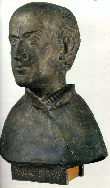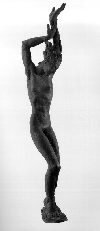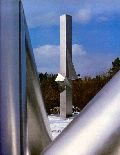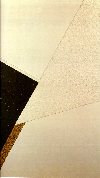
Title: Paracelsus (1961)
Media: Bronze
Size: 74.5x50.5x33
Paracelsus (real name: Theophrastus Bombastus Von Hohenheim), physician and natural philosopher, born 1493 at Einsiedln (Switzerland), died in Salzburg, 1541. He abandoned the theory of humors ascribed to Hippocrates and adopted a form of natural healing largely dependent on the body's own regenerative forces. Paracelsus treated people as physico-spiritual unities and introduced chemotherapy into medicine. Because of his revolutionary ideas Paracelsus was persecuted by supporters of the institutional medicine of the time and forced to become a wanderer. His significance for medicine was recognized only long after his death.
Related
sources

Artist:
Renee Sintenis 1888-1965
Title: Daphne (1930)
Media: Bronze
Size: 145x20x37.5
The inspiration here was the legend of Daphne with special reference to Ovid's Metamorphoses. Desperate to escape Apollo's frightening approaches, the virgin nymph Daphne called out to her father Peneious, a river god to change her into a laurel. Sintenis' sculpture shows the actual transformation of a woman into a tree. The reduced body begins to lose its human proportions. The extremely thin torso is trying to suppress any suspicion of physical similarity to a human being. The knee, elbow and breasts have become gnarled; the hair has become a streaming, almost flaming tracery of leaves. The angular silhouette describes the transformation; the pose is typical of the direction and growth of a trunk and its branches.
Related
sources

Artist:Erich
Hauser (1930-lives in Rottweil)
Title: 1/85 (1985)
Media: Steel
Size: 520x130x125
Erich
Hauser:
`` I made sculpture from steel: very concrete, round things, I think.
Perhaps they are a little bigger than what you usually find in galleries.
But I like to see my works in the open in daylight and among people. I
think of the environment, they body, people. In recent years I have had
to accept, much to my astonishment that I am a kind of political artist,
in any case as for as effect is concerned. Popeye shoot at my sculptures,
town councils get heated, and citizens take action. Although there is
plenty of evidence, in print and fact, until today I have been unable
to discover what the reason for all this upset is. I don't pull long faces
or make faces at anything, I don't want to be didactic, either politically
or in any other way. But perhaps people actually want to be indoctrinated,
converted. To be peaceful for once and open your eyes, that seems to be
the worst possible demand to make. ``
Related Sources

Artist:Carl
Buchheister (1890-1964)
Title: Diagonal composition r 533
Media: Mixed media on hardboard
Size: 90x55
``Painting abstracts`` means dividing a chosen picture-format, or picture-surface, by means of rhythm in form and color. ``The abstract painter`` does not attempt to reproduce the perspectives of a human head, an animal or a tree with painterly means. He no longer wishes to ``imitate`` anything in the broad or narrow sense. The abstract work of art arises from this refusal to imitate the externally visible form of things. ``Rhythm`` is the nature of the abstract picture. Rhythm in the picture, in the formal sense therefore, means a contrast between broad and thin, long, and short, round and angular, pointed and blunt, highly colored and gray light and dark, white and black, soft and hard, radiant and absorbing light. ``The abstract work of art``, like any artistic creation, must be a product of inner necessity. That means that the formal and color enunciation of a work is achieved as impressively as possible. Any slight change in the structure of form and color weakens the action of the picture. The rhythmic arrangement of a good abstract painting accords with the process of rhythmic occurrence in nature.
Related
sources